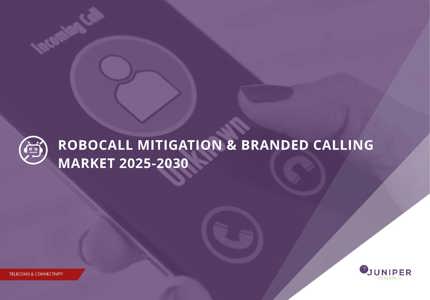Robocalling Market Insights: An Interview with Neustar
Bart Pesavento is Director of Product Marketing at Neustar. He has a proven track record studying, developing, and launching innovative networking, cloud computing, and cybersecurity solutions for enterprises around the world.
Bart Pesavento has worked in the telecommunications and authentication market for more than 20 years and is a recognised thought leader in this space.
What are the main issues associated with robocalling?
Despite an accelerated adoption of the STIR/SHAKEN framework over the past year, robocalling, call spoofing, and scams continue to plague consumers and disrupt the telecommunications industry. In 2020, the FTC (Federal Trade Commission) received over 2.2 million fraud reports, with consumers losing an estimated $3.3 billion. That's not surprising since there were 45.9 billion robocalls in 2020 alone – 45% of them scams.
Yes, the robocalling statistics are daunting, and they reflect the magnitude of the problem and the negative impact robocalling has on consumers, customers, enterprises, and CSPs (Communications Service Providers) across the globe. Enterprises have been hit particularly hard with productivity declines, loss of customers and revenue, and an overall decrease in customer satisfaction. Brand reputations have taken a real blow due to robocalling as well.
One of the most worrisome areas is the impact robocalling has had on the erosion of trust between enterprises and customers. Think about it. Legitimate business calls are answered less than 10% of the time – despite the fact that phone calls are still a critical communications channel. These drastically low contact rates play a significant role in disrupting the flow of information. Calls from schools, pharmacies, doctors, home services… I could go on and on. There’s a lot of important communications that consumers want, but it just isn’t getting through because there’s no trust.
Aside from business disruptions, let's not forget the threat to public health and safety when calls go unanswered. The consequences in these cases go way beyond just being a nuisance. Healthcare providers, government agencies, and other public safety organisations depend on reliable phone communications to act and respond during crises - but close to 90 percent of people simply don't answer their phone if they don’t recognise the number.
How does Neustar Branded Call Display (BCD) solution mitigate the risks posed by illegal and unwanted robocalls?
BCD is all about building and ensuring trusted communications. Trusted communications have been at the heart of our mission for over 20 years, and it’s why we have invested in building Branded Call Display. As the flagship product within our Trusted Call Solutions suite, Neustar BCD allows those making outbound calls to display their full name, business location, logos, e-business cards, and more – right on the mobile display. This information empowers consumers to decide if they want to answer.
Branded Call Display is an end-to-end solution that is verified with STIR/SHAKEN call authentication technology – which means it can be trusted. A single standards-based interface lets enterprises sign all outbound calls via STIR/SHAKEN and delivers branded calls across their carrier and technology partners, without the need to develop separate, proprietary, and non-scalable interfaces. Because we work with all major mobile, landline, cable, and VoIP providers, we can support over 250 million mobile devices and anticipate an increase to 325 million this year.
Customers leveraging BCD are seeing an increase in answer rates of up to 200%. In addition, BCD is helping businesses reverse revenue loss, promote and protect their brands, and restore trust in customer relationships. That’s because their verified branded calls gain the highest level of attestation through STIR/SHAKEN call authentication.
What is attestation, and what role do regulatory standards play in the mitigation of robocalling?
Although regulatory standards on their own cannot resolve robocalls, they serve an essential role, especially in helping to address the call spoofing epidemic. In 2019, Congress passed the TRACED Act, which effectively mandated a timeframe for which carriers had to comply with a protocol and standard framework designed to help protect against call spoofing. The original deadline for large carriers to abide by the TRACED Act was 30th June 2021, and smaller non-facilities-based carriers will need to comply by June 2022.
All carriers must also register in the FCC's RMDB (Robocall Mitigation Database) regarding their robocall mitigation and STIR/SHAKEN actions. There's a significant consequence for those who don't. Other carriers are not permitted to accept traffic from those who not registered in the database.
While the intent of STIR/SHAKEN is good, it may still result in legitimate calls from authentic businesses being assigned a low attestation level. This is a grade – scored from A to C – that each phone call is given based upon the degree to which the source of call data can be validated. This ‘grade’ is input into a call blocking algorithm, if the call gets a low grade, it will be labelled as spam or even blocked. This can negatively impact those brands and businesses making legitimate calls. BCD allows enterprises to leverage STIR/SHAKEN call authentication to secure their outbound calls and deliver properly branded, secure, and verified calls that are not mis-tagged as spam or blocked, and to ensure that their brand is not being spoofed.
We at Neustar are proud of our contributions to STIR/SHAKEN. We co-authored STIR as a universal standard to help authenticate calls, and we contributed to SHAKEN, which is a framework and governance structure for service providers to use when implementing STIR-using IP networks. We understand the vital role governance plays in the US and abroad, however, there is still much work to do – especially around global adoption. We intend to continue guiding the industry through regulatory and technical actions that will extend call authentication internationally.
How do you see the issue of robocalling evolving outside of the US?
Although Neustar's initial focus has been on reducing the negative impacts of robocalling within the US, robocalls are a global problem and require a global mindset and strategy. Juniper Research’s own Robocall Threat whitepaper reported that 106 billion robocalls were received by mobile subscribers in 2021 and consumers will lose $40 billion to fraudulent robocalls in 2022 alone. Those stats alone signify why the robocalling epidemic requires more attention and resources to tackle this problem across the entire telecommunications ecosystem.
The early results of STIR/SHAKEN are being closely watched by other countries, and some of the regulations have made it difficult for calls originating outside of the US. For example, the actual percentage of calls signed with the lowest level of attestation – level C – has increased as a percentage of overall calls. One might have expected it to decrease after STIR/SHAKEN, but we know that international calls often receive a lower attestation, as they move through international gateway providers. But obviously not all international calls are robocalls.
Billions of legitimate international calls coming into the US are at risk of receiving unfavourable treatment and being mislabelled as spam or blocked because operators may not be able to identify the originating network, especially without a universal call authentication standard in place.
What is promising about the evolution of robocalling outside the US is that, according to the FCC Robocall Mitigation Database, 127 countries have implemented STIR/SHAKEN in some capacity to support US-based calls, with over 4,000 carriers having implemented robocall mitigation programs to date. That is progress, and the world is taking this problem seriously. For our part, Neustar has led the charge and has worked very closely with Canada on their STIR/SHAKEN implementation. Our support in Canada includes:
- Running the Number Portability platform
- Assuming the PA (Policy Administrator) function
- Serving as the main CA (Certificate Authority) for call authentication
What lessons can be learned from robocalling mitigation in the US?
Countries across the globe are taking steps to determine whether STIR/SHAKEN are viable call authentication processes that meet their unique needs. Developed by the IETF (Internet Engineering Task Force) and co-authored by Neustar, STIR was designed as a universal standard to deploy in any country to help authenticate calls. SHAKEN, meanwhile, is related to how the STIR standard should be deployed and managed. This will be different for each country, depending on how they assign and manage telephone numbers, their own regulatory requirements, and network infrastructure. Another way to distinguish between the two is that STIR focuses on the ‘what’ while SHAKEN focuses on the ‘how’. It’s up to each nation or region to figure out the ‘how’.
One of the most valuable lessons that other countries can learn from the US is recognising that combatting robocall mitigation cannot be achieved independently. Better call authentication requires broad participation internationally among CSPs, enterprises and regulators. The United Kingdom is exploring implementing the STIR framework this year and France has mandated call authentication be implemented by June 2023. Other countries, including Brazil, India and Australia, are working on their own strategies.
How can stakeholders outside of North America prepare themselves for the emergence of illegal and unwanted robocalling?
Stakeholders can take part in Neustar's Trust Lab, which serves as the industry's virtual testbed for CSPs, equipment manufacturers, and software suppliers across the globe to remotely test call authentication solutions like STIR/SHAKEN.
Launched in 2017, the ATIS-supported interoperability test facility helps validate the effectiveness of caller authentication standards and solutions that combat illegitimate call spoofing. The testbed has helped carriers and suppliers meet the US deadline for STIR/SHAKEN implementations and continues to provide support to carriers on an ongoing basis. While there have been estimates that it will take 10 years for full deployment across the globe, we believe we have accelerated adoption via the testbed and are discussing setting this up for other countries. We have already performed testing with carriers from Canada, China, Malaysia, Mozambique, and Singapore.
► Find out more about Neustar
Visit the Neustar website for more details about their Trusted Call Solution.
https://www.home.neustar/trusted-call-solutions
► Robocall Mitigation Market Research
Our latest research found:
- Consumers will lose $40 billion to fraudulent robocalls globally in 2022; rising from $31 billion in 2021.
- Emerging mitigation frameworks will combat fraudulent robocalls by creating an ecosystem in which brands and enterprises are verified before the call is placed.
- Brand authentication technologies will be a critical element of these frameworks.
- North America is the region most afflicted by fraudulent robocalling; accounting for 45% of global losses next year, despite representing just 5% of mobile subscribers.
Latest research, whitepapers & press releases
-
 ReportDecember 2025
ReportDecember 2025AI Agents for Customer Experience Platforms Market: 2025-2030
Our comprehensive AI Agents for Customer Experience Platforms research suite comprises detailed assessment of a market that is set to disrupt mobile communications. It provides stakeholders with insight into the key opportunities within the AI agents for customer experience platforms market over the next two years.
VIEW -
 ReportDecember 2025Fintech & Payments
ReportDecember 2025Fintech & PaymentseCommerce Fraud Prevention Market: 2025-2030
Our eCommerce Fraud Prevention research suite provides a detailed and insightful analysis of this evolving market; enabling stakeholders from financial institutions, law enforcement agencies, regulatory bodies and technology vendors to understand future growth, key trends, and the competitive environment.
VIEW -
 ReportNovember 2025Telecoms & Connectivity
ReportNovember 2025Telecoms & ConnectivityeSIMs & iSIMs Market: 2025-2030
Juniper Research’s eSIMs and iSIMs research suite offers insightful analysis of a market set to experience significant growth in the next five years. The research suite provides mobile network operators (MNOs), original equipment manufacturers (OEMs), and eSIM management and platforms vendors with intelligence on how to capitalise on the market growth, and guidance on how eSIM-only devices and sensors, SGP.42, in-factory provisioning, and iSIMs will change the competitive landscape.
VIEW -
 ReportNovember 2025Fintech & Payments
ReportNovember 2025Fintech & PaymentsModern Card Issuing Platforms Market: 2025-2030
Our Modern Card Issuing Platforms Market research suite provides a detailed and insightful analysis of this evolving market; enabling stakeholders from banks, financial institutions, fintech companies, and technology vendors to understand future growth, key trends, and the competitive environment.
VIEW -
 ReportNovember 2025Fintech & Payments
ReportNovember 2025Fintech & PaymentsDigital Wallets Market: 2025-2030
Our digital wallets research suite provides detailed analysis of this rapidly changing market; allowing digital wallet providers to gain an understanding of key payment trends and challenges, potential growth opportunities, and the competitive environment.
VIEW -
 ReportOctober 2025Fintech & Payments
ReportOctober 2025Fintech & PaymentsDigital Identity Market: 2025-2030
Juniper Research’s Digital Identity research suite provides a comprehensive and insightful analysis of this market; enabling stakeholders, including digital identity platform providers, digital identity verification providers, government agencies, banks, and many others, to understand future growth, key trends, and the competitive environment.
VIEW
-
 WhitepaperDecember 2025Telecoms & Connectivity
WhitepaperDecember 2025Telecoms & ConnectivityHuman + AI: Drivers of Customer Experience AI Agents in 2026
Our complimentary whitepaper, Human + AI: Drivers of Customer Experience AI Agents in 2026, examines the key drivers of the AI agents for customer experience platforms market in 2025.
VIEW -
 WhitepaperDecember 2025Fintech & Payments
WhitepaperDecember 2025Fintech & PaymentsBeyond Chargebacks: The True Cost of Fraud for Digital Commerce
Our complimentary whitepaper, Beyond Chargebacks: The True Cost of Fraud for Digital Commerce, examines the state of the eCommerce fraud prevention market; considering the impact of evolving digital fraud strategies, including key trends such as identity theft, account takeovers, chargebacks, policy abuse and friendly fraud.
VIEW -
 WhitepaperNovember 2025Telecoms & Connectivity
WhitepaperNovember 2025Telecoms & ConnectivityeSIM-only Devices: The Impact on Operators, Consumers, and IoT
Our complimentary whitepaper, eSIM-only Devices: The Impact on Operators, Consumers, and IoT, explores the challenges and opportunities for the three segments, with a particular focus on eSIM-only smartphones and SGP.42.
VIEW -
 WhitepaperNovember 2025Fintech & Payments
WhitepaperNovember 2025Fintech & PaymentsUnlocking the Next Stage of Growth for Modern Card Issuing Platforms
This free whitepaper analyses key trends shaping the modern card issuing space, and the ways in which modern card issuing platforms can capture growth.
VIEW -
 WhitepaperNovember 2025Fintech & Payments
WhitepaperNovember 2025Fintech & PaymentsTop 10 Fintech & Payments Trends 2026
Fintech is evolving fast. From stablecoins to agentic AI, our annual guide reveals the shifts redefining payments, digital identity, and the future of money in 2026. Download your copy today.
VIEW -
 WhitepaperNovember 2025Fintech & Payments
WhitepaperNovember 2025Fintech & PaymentsDigital Wallets: Empowering Financial Inclusivity
Our complimentary whitepaper, Digital Wallets: Empowering Financial Inclusivity, examines the state of the digital wallets market; considering the impact of digital wallets on different geographies, how they are shaping the modern payments landscape through lower transaction fees and promoting financial inclusivity for underbanked populations, and how they are competing with established payment methods.
VIEW
-
IoT & Emerging Technology
Juniper Research Unveils Top 10 Emerging Tech Trends to Watch in 2026
January 2026 -
Fintech & Payments
Digital Identity App Usage to Hit 6.2 Billion by 2030, Driven by Shift to Decentralised Models
December 2025 -
Telecoms & Connectivity
Travel eSIM Margins Under Pressure as Revenue per Gigabyte Falls 10% Globally in Two Years
December 2025 -
Telecoms & Connectivity
AI Agents to Power 1,000% More Customer Interactions for Enterprises Globally by 2027
December 2025 -
IoT & Emerging Technology
Global D2C Revenue Set for $370 Million Surge, But Satellite Operators Should Not Chase Full MNO Status
December 2025 -
Fintech & Payments
Digital Goods Fraud to Cost eCommerce Merchants $27 Billion Globally by 2030 as AI Tools Accelerate Attacks
December 2025





















